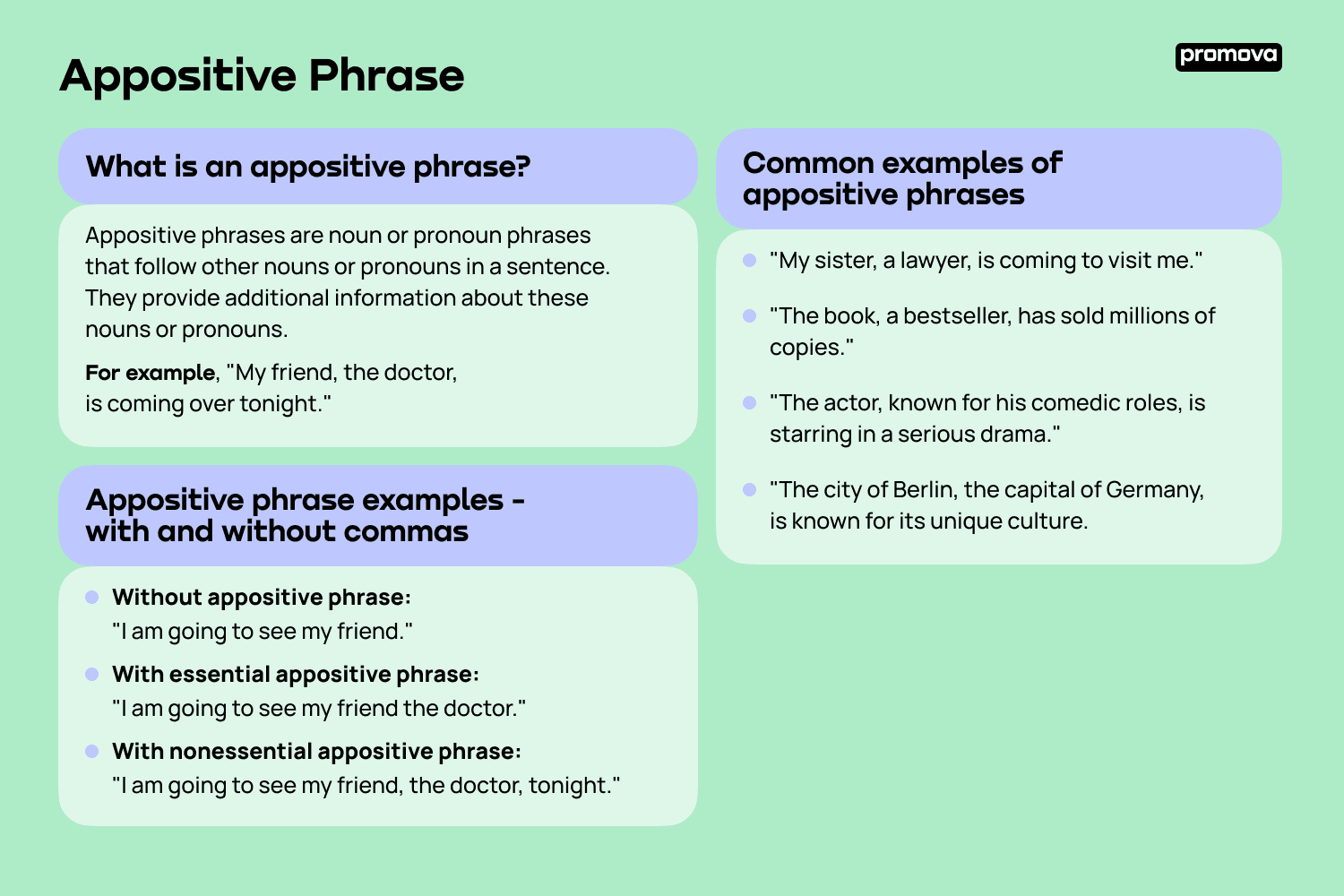Appositive Phrase
Contents
An appositive phrase is a grammatical structure that consists of a noun or pronoun phrase that renames, explains, or clarifies another noun or pronoun in a sentence. It is a type of modifier that can be essential or nonessential to the sentence's meaning. When used correctly, appositive phrases can add clarity, detail, and emphasis to a sentence. Let's dive deeper into this idea!
What is an appositive phrase?
Appositive phrases are noun or pronoun phrases that follow other nouns or pronouns in a sentence. They provide additional information about these nouns or pronouns.
It is a type of modifier that can be essential or nonessential to the sentence's meaning. An essential appositive phrase is necessary to identify the noun or pronoun it modifies, while a nonessential appositive phrase can be removed from the sentence without affecting its meaning.
For example, "My friend, the doctor, is coming over tonight."
In this sentence, "the doctor" is an appositive phrase that renames "my friend." The appositive phrase is nonessential because the sentence still makes sense without it: "My friend is coming over tonight." However, it adds useful detail and emphasis.

Common examples of appositive phrases
Appositive phrases are commonly used in writing and speech to provide additional information about a noun or pronoun. Some common examples of appositive phrases include:
- "My sister, a lawyer, is coming to visit me."
- "The book, a bestseller, has sold millions of copies."
- "The actor, known for his comedic roles, is starring in a serious drama."
- "The city of Berlin, the capital of Germany, is known for its unique culture.
In each of these examples, the appositive phrase provides us information about the noun or pronoun it modifies, adding detail and emphasis to the sentence.
The different types of appositive phrases
Appositive phrases can be essential and nonessential.
An essential appositive phrase is necessary to identify the noun or pronoun it modifies, while a nonessential appositive phrase can be removed from the sentence without affecting its meaning.
- "My wife, Sarah, is a teacher." In this sentence, "Sarah" is an essential appositive phrase because it is necessary to identify the noun "wife." Without the appositive phrase, the sentence would be unclear: "My wife is a teacher."
- "My uncle, an engineer, is coming to dinner," is an example of a nonessential appositive phrase. In this sentence, "an engineer" provides additional information about "my uncle," but the sentence still makes sense without it: "My uncle is coming to dinner."
1
Appositive phrases vs other grammatical structures
Appositive phrases are often confused with other grammatical structures, such as noun clauses and adjectives.
A noun clause is a set of words that serves as a noun in a sentence. It often begins with words like "that," "whether," or "if."
For example, "I know that she is coming."
In this sentence, "that she is coming" is a noun clause that functions as the direct object of the verb "know."
An adjective simply describes a noun or pronoun in a sentence.
For example, "The red car is mine."
In this sentence, "red" is an adjective that describes the noun "car."
An appositive phrase, on the other hand, renames, explains, or clarifies another noun or pronoun in a sentence. It is a type of modifier that can be essential or nonessential to the sentence's meaning.
Appositive phrase examples - with and without commas
To further illustrate the use of appositive phrases, here are some examples of sentences with and without appositive phrases:
- Without appositive phrase: "I am going to see my friend."
- With essential appositive phrase: "I am going to see my friend the doctor."
- With nonessential appositive phrase: "I am going to see my friend, the doctor, tonight."
In the first sentence, there is no appositive phrase. In the second sentence, "the doctor" is an essential appositive phrase because it is necessary to identify which friend the speaker is going to see. In the third sentence, "the doctor" is a nonessential appositive phrase because it can be removed from the sentence without affecting its meaning.
Summary
By understanding the structure and function of appositive phrases, you can use them effectively in your writing and speech to add clarity, detail, and emphasis to your sentences. To use appositive phrases correctly, you must place them directly after the noun or pronoun they modify and separate them from the rest of the sentence with commas if they are nonessential.
Check out more handy references to help you master grammar right below this one!



Comments